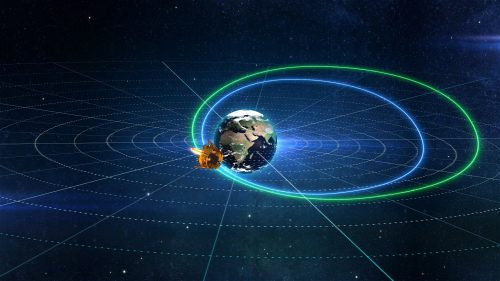The Israeli spacecraft Genesis of the SPACEIL association and the Aerospace Industry makes its way to the moon after the successful launch on Friday. The first maneuver was intended to raise the lower part of the spacecraft's orbit from 200 km to 600 km. The focus will be on the high part

Yesterday (Sunday) the first maneuver of the Bereshit spacecraft was successfully completed by the engineering team of SpaceIL and the Aerospace Industry.
The maneuver was designed while incorporating and taking into account the limitations identified in the star trackers after the launch. This is the first time the Genesis engine was activated, and the activation was successful.
Unlike the maneuvers that will come after it, this maneuver was performed when Beresheet was at the height of its initial orbit or the far part of its orbit - 69,400 km. The spacecraft's engines were ignited for thirty seconds, to increase the distance at the point where the spacecraft will be close to the Earth from about 200 km to 600 km. In the following maneuvers, the engine activations will be performed when the spacecraft is close to the Earth, in order to raise its orbit each time.
The maneuver was successful, Bereshit continues on its course according to the plan, and the next maneuver is planned for Monday night.
As you may recall, the Bereshit spacecraft was launched on the night between Thursday and Friday (22/2/19) from Cape Canaveral in Florida by SpaceX's Falcon 9 launcher as one of two ancillary payloads attached to the launch of a communications satellite.
The launch was declared successful, and the four landing legs opened at the beginning. As soon as contact was made with the spacecraft - about half an hour after launch, the engineers performed tests of the spacecraft in orbit and then discovered the malfunction that caused the star trackers, components that help navigate the spacecraft, to be highly sensitive to being dazzled by the sun's rays. As mentioned in yesterday's maneuver, the engineers took into account the consequences of the malfunction.
The spacecraft will circle the ISS in elliptical orbits and will travel 6.5 million km - this is the longest orbit ever made to land on the moon. During these rotations, the spacecraft will raise its orbit around the Earth, until its edge reaches the vicinity of the moon. When the spacecraft will be captured in lunar orbit about ten days before landing, it will circle it until the appropriate time and begin the process of landing that will be carried out autonomously. As mentioned, the route will last about two months until the expected landing on April 11, 2019.
A video explaining the maneuvers that the control room engineers will perform in order to raise the trajectory of the Bereshit spacecraft, up to an altitude of about 400 km, a trajectory where it is supposed to be captured by the moon.

2 תגובות
Amazing! The calculations of the flight path are at an unbelievable level - beautiful! Using the basics of Newton's classical physics - even after 400 years!!!
What happened to the star cameras? It is said that these are standard products off the shelf. Forgot to install the cone that hides the sun? Another matter: the photo of the spaceship in the left column of the science site is different from how the spaceship actually looks (a parallel unit without the electronics was placed in HaTarbut square in Tel Aviv). The legs in the photo are arched, while what actually exists are straight legs, and they seem to contain shock absorbers.